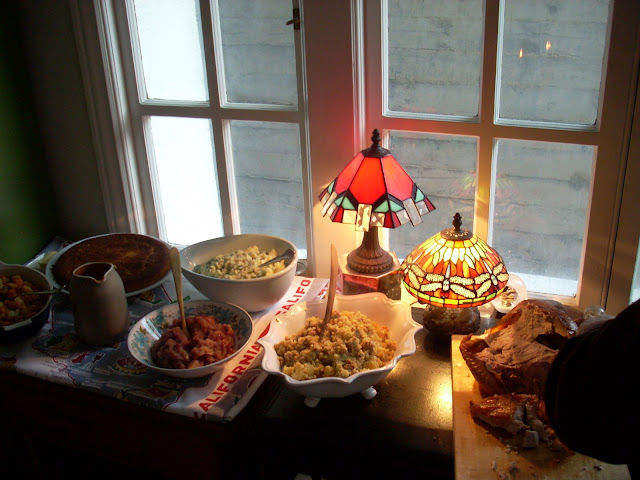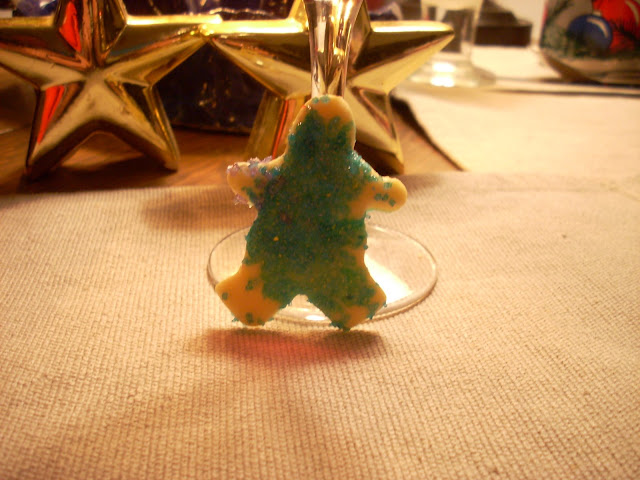
The hostess, wearing her apron, takes a break to sit down and talk for a minute with guests at her San Francisco flat. Christmas dinner is going forward in the kitchen like an avalanche that will happen with or without human intervention.


The table waits in patient perfection.

The hard-working host in his own apron of serious stripes also manages some socializing in mid-stream.

There are good snacks along the way to keep up everyone's strength.


A friend is caught here in the very act of agreeing to carve the turkey. He is holding a clipping from
Gourmet Magazine with instructions, but very wisely is not promising to follow them.


Two of the locally-obtained and frugal presents emerge from under the tree to join in the revelry.




Detail of a new rug that entered the environment to complement the new slipcover on the sofa (visible below and lavishly documented
here).









But this quiet interlude is shattered by the sudden emergence of the
Bird. Now, in public, for all to see, it is time to wield the thin sharp flexible knife endorsed by
Gourmet Magazine.





The food is simple yet amazing, from the fresh-Lima-beans to the roasted-root-vegetables to the two-polentas-stuffing, to the apple-cranberry-sauce to the herbed-mashed-potatoes and gravy. Plus that turkey, of course, as if Houdini had carved it from beyond the grave.



The first course is a chestnut soup, an unlikely yet soothing soup.




There are two desserts. A dried-fruit, mince pie of rich aroma, and a red-velvet cake, insufficiently pictured here with its triumphant creator but with no hint of the tasty scarlet glory that will be revealed once she cuts it open.

Darkness falls early and a certain meditative torpor overcomes the party. Focus is softened.


There are sonic side-effects at this point that do not lend themselves to photographic preservation. A silver-plated martini-shaker lid turns itself into a flying saucer, and the carved wooden folklore-type cicada-noisemaker (it makes its home with the bar tools) gets co-opted by our turkey-carving comrade for the soundtrack. And then the Jon Carroll Christmas quiz of famous surpassing difficulty gets read out loud to the company. Most of the questions cannot be answered by anybody, which is a comfort of a sort. One question concerns the opera Madama Butterfly. Her lover Pinkerton is named after a famous American. What famous American? Now, I know (from 7,000 listenings to the Callas recording) that Butterfly refers to herself as "Madama F.B. Pinkerton" – but I cannot think of any famous American with initials F.B. Today I cheat, and discover on the web that Pinkerton's full name is Benjamin Franklin Pinkerton, but that Butterfly reverses the initials to conform to the Japanese custom of putting the surname first. So that is an excellent example of why Jon Carroll's Christmas quiz is notoriously hard.
















 Elisabeth of Bavaria, Empress of Austria posing in Vienna in the 1860s. A simple, sober day-dress. This lady was the mother of Crown Prince Rudolph who committed suicide in 1889 with his mistress at Mayerling. Elisabeth herself died ten years later, in 1898. She was assassinated by a young anarchist using a sharpened file. "I wanted to kill a royal," said Luigi Lucheni. "It did not matter which one."
Elisabeth of Bavaria, Empress of Austria posing in Vienna in the 1860s. A simple, sober day-dress. This lady was the mother of Crown Prince Rudolph who committed suicide in 1889 with his mistress at Mayerling. Elisabeth herself died ten years later, in 1898. She was assassinated by a young anarchist using a sharpened file. "I wanted to kill a royal," said Luigi Lucheni. "It did not matter which one."

















































